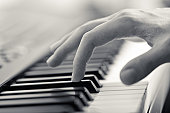
Home > Video Piano Lessons > Learn the Basics
|
||||
Learn the Basics of Piano Playing
Riding a bike requires specific skills that take time to develop, like balance, pedaling, and steering. Young bike riders who just had their training wheels removed know that it is difficult to manage all three of those things at once, and more often than not end up falling over into thorny bushes. Learning the piano likewise requires several specific skills, like reading music, developing techniques, and recognizing patterns. Although learning piano may prove equally frustrating, you won’t end up in any thorn bushes unless you’re doing something incredibly wrong. The basics of playing piano are generally divided into two intimately related categories: reading music and developing skills. This is like the equivalent of knowing how to read an instruction manual for that monstrous train set for your kid, and then actually being able to put it together. Fortunately, you’ll find that, even though learning these takes time and doubtlessly will prove frustrating, there is little more rewarding than listening to beautiful music and then looking down to find your very own fingers dancing out the notes on the keys.The fundamental skills every aspiring pianist should initially dig into – even before beginning to play songs – are called scales, arpeggios, and chords. This lesson was brought to you by Piano System
For example, Beethoven’s Moonlight Sonata might sound rich, dark, and complex, but knowing that the piece is composed in the key called C# minor means that you automatically know that certain notes on the piano are going to be played, and certain notes in all likelihood are not. What’s even better is that not only do you know, but your fingers – after hours and hours of playing scales – know too. Yes, I said hours and hours of playing piano scales. The famous pianist and piano exercise writer Czerny once said that if an individual has a tune in mind, but has difficulty finding that tune on the piano keys, then he doesn’t know his scales! And what’s more, all professional pianists will proudly report that they spend much of their rehearsal time reviewing scales. Just as golfers always practice strokes, basketball players free throws, and chess players opening sequences, the pianist who knows how to play will always practice the basics of piano. So get those fingers moving across your scales! In addition to practicing scales, other basics include elements called arpeggios and chord progressions. Even though these might sound as enticing as a mouthful of mushy pasta, they comprise the fundamental elements of piano theory and technique. A useful way to practice is to begin in the key of C, play the scales over several octaves multiple times, play the arpeggios over several octaves multiple times, and play the chord progressions and inversions multiple times. This approach sounds like a daunting exercise routine from an anal personal trainer. While it won’t help you lose weight, it will undoubtedly help your fingers master the basics of playing piano. Within only a short amount of time you will be able to look down and see your own fingers dancing on the keys, not only playing lifeless exercise techniques, but beautiful compositions as well.
http://pianoplayerworld.com/300PagePianoWorkbook.html
| ||||
|
Although every attempt has been made to make information as accurate as possible, we are not responsible for any errors that may appear.
 It would be cliché to say that the basics of playing piano are like the
basics of riding bike, but the parallels are too similar to pass up.
It would be cliché to say that the basics of playing piano are like the
basics of riding bike, but the parallels are too similar to pass up.
 Scales form the backbone of all music theory, which is ironic since fish and
snakes are invertebrates. Every single song ever written has at its heart a scale, or what may be called a
“key.” Knowing scale and key of a song will unlock doors to levels of understanding that were previously
closed.
Scales form the backbone of all music theory, which is ironic since fish and
snakes are invertebrates. Every single song ever written has at its heart a scale, or what may be called a
“key.” Knowing scale and key of a song will unlock doors to levels of understanding that were previously
closed.



